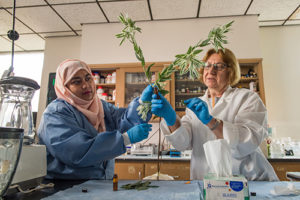‘SNOW ON THE PRAIRIE’ IS NATIVE TO THE REGION AND FULL OF POTENTIAL
According to the Centers for Disease Control and Prevention, 130 Americans die every day from opioid overdose. Researchers and graduate students at Texas Woman’s University (TWU), however, may have found a plant-based alternative that could result in saving hundreds of lives.

Euphorbia bicolor is the plant’s scientific name. It is better known as “Snow on the Prairie” and is native to the DFW Region, Oklahoma, parts of Arkansas and Louisiana and is the focus of research for TWU botanist Dr. Camelia Maier and TWU neuroscientist Dr. Dayna Averitt, alongside TWU alumna Dr. Paramita Basu. “It doesn’t grow anywhere else in the world,” says Maier. Maier is one of the first scientists to study the plant and says Native Americans used Snow on the Prairie for pain relief, which led her to study its effects for modern medicine.
TWU researchers have discovered a chemical inside the plant’s sap that, when used on tissue samples from animals, immediately stopped pain signals at the source of an injury — unlike opioids, which change the chemistry of the brain and can lead to addiction.
“We’re trying to target the signals as they make their way to the brain,” Averitt explains. “So if we can turn them off like a light switch for a long period of time, the brain doesn’t even know about it and you don’t have that pain.”
Don’t try to pull sap from the plant on your own, researchers warn the public, because the sap is toxic and cannot be ingested. If used for medical purposes, it would be injected into the site of the pain — directly into an aching back or a burned arm, for instance.
The TWU euphorbia bicolor research has been published but still faces challenges before clinical trials.
“We need to make sure it doesn’t hurt other cells,” Averitt said. “You’re harming nerve endings, which we want to do, but we want to make sure it isn’t acting as a toxin on other cells as well.
“You can’t help but look to the future and be excited, like maybe this could be something that could be a real breakthrough.”
This article is part of the 2020 Higher Education Review Magazine.